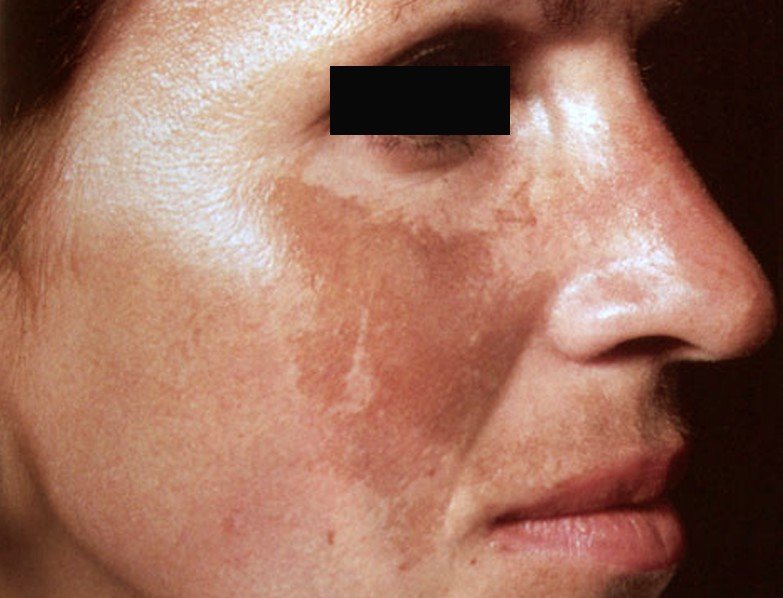Melasma
Amit G. Pandya, MD
 Melasma is a pigmentary disorder of the skin which appears as brown patches on the face
Melasma is a pigmentary disorder of the skin which appears as brown patches on the face
of adults. Both sides of the face, especially the cheeks, bridge of nose, forehead, and
upper lip, are involved. Some patients may have mild involvement in just a few of the
above areas. This condition is very common, particularly those with darker skin types.
Who does melasma affect?
Melasma predominantly occurs in people with skin of color, and 90% are women.
Latin- America, Asia, Middle East, and Northern Africa are areas with a higher
prevalence of melasma. Patients with brown skin, particularly in areas of high sun
exposure, are especially susceptible to getting melasma.
What is the cause of melasma?
Although the exact cause of melasma is unknown, affected people often have a
family history of melasma. In addition, a change in hormonal status, particularly
pregnancy and birth control pills, are commonly associated with melasma, and melasma
is often referred to as the “mask of pregnancy”. Post-menopausal hormone replacement
therapy has not been shown to cause melasma.
Sun and light exposure are some of the most common reasons for the appearance
of melasma. Ultraviolet light from the sun and visible light from light bulbs can stimulate
pigment-producing cells in the skin called melanocytes to produce more pigment.
Melanocytes are particularly active in those with brown or black skin. Even small
amounts of light exposure, such as driving in a car or walking in a parking lot to a store
can induce melasma and may account for the long duration of this condition in many
people. Irritation of the skin can produce a brown color as it heals, and any irritation of
the face in those with melasma may cause it to worsen. Although melasma can cause
significant brown staining of the skin as well as psychological stress and a negative
impact on quality of life, it is localized only to the skin and is not associated with any
internal diseases or organ malfunction.
How do I know if I have melasma?
Because of its characteristic appearance, melasma can usually be easily diagnosed
by a dermatologist with a skin examination. Biopsy of the skin may be sometimes
necessary in order to differentiate melasma from other conditions.
What are the best treatments for melasma?
Several treatments are available for melasma, but none work in every patient.
While some patients have melasma only for a few weeks or months, many have it for
years or decades. Pregnancy-associated melasma usually resolves within a few months
after delivery, although women in sunny climates may have persistence of the
pigmentation for many years. Because the sun and lighting are major causes of melasma,
sunscreens are very important in any treatment plan. Broad spectrum sunscreens, which
protect against UVA and UVB ultraviolet light should be used. A physical block, such as
zinc oxide and titanium oxide, may be used on top of chemical sunscreens to block light
even more. Daily use of sunscreens is important, since even small doses of light can
worsen melasma. Visors and tinting can protect from ultraviolet light while driving.
Oral contraceptive pills may need to be discontinued if they cause melasma.
Irritating creams or makeup should be stopped, and the skin should be treated as gently as
possible.
While many bleaching creams are available for the treatment of melasma, these
agents do not actually “bleach” the skin by destroying the melanocytes, but reduce their
activity. Hydroquinone is the most commonly used depigmenting agent and is available
in low strengths over the counter and in higher strengths through prescription from a
physician. Hydroquinone is the most effective of all the depigmenting agents, and takes
3-6 months to reach maximum results. Combination creams containing tretinoin, steroids,
and glycolic acid along with hydroquinone enhance its depigmenting effect. Azelaic acid
and kogic acid are two other agents that have depigmenting effects and are effective for
many patients. Several over the counter natural products are available to bleach the skin
and may be effective for mild cases of melasma. Various procedures, including chemical
peels, microdermabrasion, and laser surgery have been used in patients with melasma,
but results so far have not been consistent. Procedures like these, which remove layers of
the skin, have the potential of causing significant irritation, which can worsen melasma.
If done properly, however, these procedures may produce some benefit in selected
patients. Generally, these procedures should be performed with great care by those who
are familiar with their use in patients with skin of color.
In summary, while melasma can be a persistent, frustrating and difficult skin disorder, a
comprehensive management approach, including avoidance of sun and irritants, use of
sunscreens, depigmenting agents, occasional procedures, and close supervision by your
dermatologist can lead to a successful outcome.
Download Spanish translation.
Descarga traducción en español.

Cutis Journal
Read published peer-reviewed articles written your by Skin of Color Society members

Did You Know
Skin of color patients comprise the majority in California, New Mexico and Texas…and soon will be the majority in Arizona, Nevada, Georgia, New York and Florida.
By 2042, more than 50% of the US population will have skin of color.




